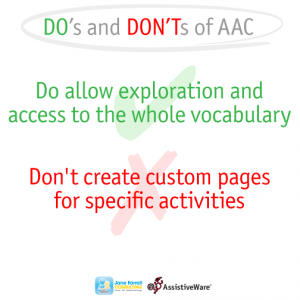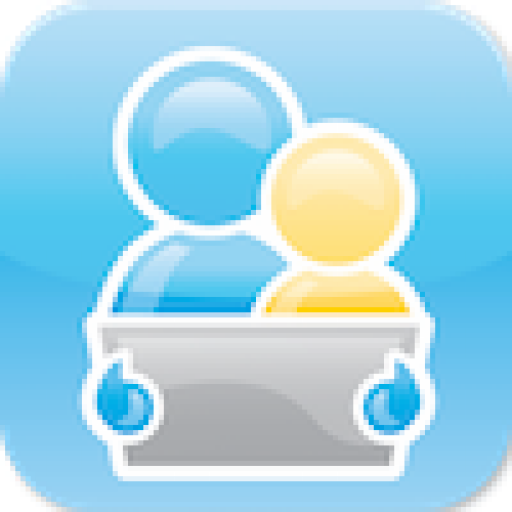My last blog post was about a Do’s and Don’ts of AAC Poster that we made up for International AAC Awareness Month. (The “we” in there is myself and David Niemeijer from AssistiveWare).
There’s been a few comments and questions about one of the “Don’t” statements. So I wanted to clarify what we meant when we said “Don’t create custom pages for specific activities”. In our original presentation it actually said “don’t focus on creating custom pages for specific activities” but we shortened it for the poster – which may have created some of the confusion!

We realise that many people start using Augmentative and Alternative Communication with scripted or topic pages. We understand that this is a good starting point for some people – they can be highly motivating and using this approach we can experience a lot of success, which is great for all of us. Sequenced Social Scripts (Burkhart & Musselwhite, 2001) are one of my favourite starter activities to get people really motivated and excited about the power of communication.
But the problem with these activity or specific displays is that they don’t develop overall language. So – we need to make sure that every AAC user is allowed to explore and access the whole vocabulary in a comprehensive communication system e.g. core vocabulary or PODD.
As an example, I’ve seen lots of students in classrooms who have a special page for their morning circle under a category called “school”. One day I’ll write a blog post about morning circle – but in the meantime I’ll use this as an example of where an activity display lets us down. Students in these classrooms go to class in the morning and their systems are often already on the morning circle page – or they are prompted by someone to navigate to the page. On this page they can greet their classmates, talk about the weather and make comments about who is at school today. This highly scripted situation also usually contains a strong routine and lots of expectant pauses – which scaffold students to do well during that period.
However, these scaffolds don’t exist in other situations – and the morning circle vocabulary doesn’t get used in other situations. Additionally, because it is stored under the category called “school” it implies it is only used at school. This means that the students usually don’t know how to use it outside the morning circle session and definitely not outside of school. So, when they see a friend in the street they don’t know how to say “hello” because they have never been shown how to navigate to it independently in their AAC system; or because they can only say hello after an expectant pause and a few hints; or they can only say hello in the heavily scripted routine of morning circle. They also don’t know how to say the friend’s name because they’ve never been taught how to navigate to the people section of their system.
When there is a storm at night, they don’t know how to comment on it or to describe it because they have never been taught this. They might be able to easily tell us in morning circle what the weather looks like outside the window each morning – but conversations about the weather never consist simply of “sunny”. They contain phrases like “gorgeous day” or “raining cats and dogs” or “it’s so loud”. These students can’t generate these comments because they don’t know how to navigate to the weather page or the descriptions page. They don’t know how to string words together independently to produce a comment. And they probably don’t even think of using the morning circle page because it is only used in morning circle at school!
Instead of making a morning circle page, we should teach the students to go to chat or social vocabulary to say hello and then onto people to use someone’s name. We should teach them to go to the weather section of their system to tell us about the weather and then onto descriptions to make a comment about it. And we should demonstrate using these skills whenever we greet people or comment about the weather throughout the day – and not just in morning circle and definitely not just at school. This is how we get overall communication development, including language and vocabulary development.
Earlier this year, I published an article called “Implementation of iPads for AAC in a specialist school“. In this article I describe the changes when we moved on from an activity display approach and instead started using robust language. Using a comprehensive communication setup, the students began to develop as autonomous communicators. They learned the power, not just of communication, but also of language.
Of course, there are other problems with an activity specific approach to AAC. Balandin and Iacono (1998) found that it isn’t easy to predict what is going to be said in many situations. During mealtimes we talk about many, many things – and yet “mealtime AAC displays” tend to focus on food and comments about the food. To truly participate in the conversation at mealtimes a person using AAC needs access to the robust vocabulary so that they can jump into the conversation about what happened on the weekend or the one about twerking!
Additionally, if we always make activity specific displays, we miss out on a fabulous opportunity to model and use strategic competence (Light & McNaughton, 2014). Strategic competence is, among other things, the ability to make the best use of the vocabulary in the AAC system. There will always be vocabulary limitations in any AAC system as we will never be able to include every single word – so it’s good to learn and practice strategies to get around this limitation. This is especially important for someone who is in the early stages of developing their literacy skills.
As an example, last year a teacher asked me to add an Australian Animals page into a student’s AAC system. We talked about the vocabulary that she wanted added. The vocabulary included the names of Australian animals and some key terms she felt were important to the topic. First of all, I pointed out that many of the Australian animals were already in the animals section – and that it would be more logical to add any extra ones into that section so that they could be accessed again and again. Then we talked about the extra vocabulary she wanted added. These were words like nocturnal and diurnal. I suggested that this was a really good time to model strategic competence. So, instead of adding these two very low frequency words, the teacher used this as an opportunity to model describing what the words mean. So for nocturnal, she used the phrase “awake at night” and for diurnal she used the phrase “awake in the day”. The result was that they completed this whole unit without adding an extra page – and just adding some animal names into the animals section and some habitat names into places. And nocturnal and diurnal probably made a lot more sense to all of the students since they were constantly defined!
So having finished my blurb about why we shouldn’t focus on activity specific displays, I’ll tell you that I still use them occasionally. But I only use them for occasions when the student needs to reduce their anxiety or when timing is really important. So – I’ll make a page for the school concert so that someone can say their lines with minimum stress. I’ll make a page for Christmas Day so that they can exchange greetings and information about presents quickly with their cousins that they only see once a year. Or I’ll make a page for McDonalds so that they can place their favourite order easily. But most of the time I want them to use their robust vocabulary to communicate as autonomously as possible – so generally they use the vocabulary in their system to generate their own language throughout the day and situation specific displays are only made rarely and for really good reasons.


berkowitzssusanberkowitz
jane
Genevieve Ricci
jane
Genevieve Ricci
Cristi
jane
Karen Trengove
jane
radicielena
jane
Julie
jane
Sean Early
jane
Dana
jane
Dana
jane
Pat King-DeBaun
jane
Pat King-DeBaun
lu
jane
shafferjm
jane
Cristi
Amanda Hartmann
Rachel
jane
Maureen MacGowan
jane